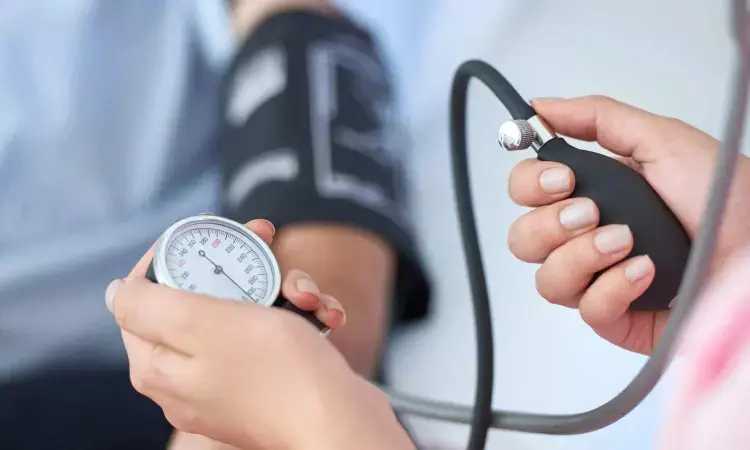- Home
- Medical news & Guidelines
- Anesthesiology
- Cardiology and CTVS
- Critical Care
- Dentistry
- Dermatology
- Diabetes and Endocrinology
- ENT
- Gastroenterology
- Medicine
- Nephrology
- Neurology
- Obstretics-Gynaecology
- Oncology
- Ophthalmology
- Orthopaedics
- Pediatrics-Neonatology
- Psychiatry
- Pulmonology
- Radiology
- Surgery
- Urology
- Laboratory Medicine
- Diet
- Nursing
- Paramedical
- Physiotherapy
- Health news
- Fact Check
- Bone Health Fact Check
- Brain Health Fact Check
- Cancer Related Fact Check
- Child Care Fact Check
- Dental and oral health fact check
- Diabetes and metabolic health fact check
- Diet and Nutrition Fact Check
- Eye and ENT Care Fact Check
- Fitness fact check
- Gut health fact check
- Heart health fact check
- Kidney health fact check
- Medical education fact check
- Men's health fact check
- Respiratory fact check
- Skin and hair care fact check
- Vaccine and Immunization fact check
- Women's health fact check
- AYUSH
- State News
- Andaman and Nicobar Islands
- Andhra Pradesh
- Arunachal Pradesh
- Assam
- Bihar
- Chandigarh
- Chattisgarh
- Dadra and Nagar Haveli
- Daman and Diu
- Delhi
- Goa
- Gujarat
- Haryana
- Himachal Pradesh
- Jammu & Kashmir
- Jharkhand
- Karnataka
- Kerala
- Ladakh
- Lakshadweep
- Madhya Pradesh
- Maharashtra
- Manipur
- Meghalaya
- Mizoram
- Nagaland
- Odisha
- Puducherry
- Punjab
- Rajasthan
- Sikkim
- Tamil Nadu
- Telangana
- Tripura
- Uttar Pradesh
- Uttrakhand
- West Bengal
- Medical Education
- Industry
New Blood Pressure Guidelines: 10 Practice-Changing Updates to Know

Philadelphia: The highly anticipated ''2025 AHA/ACC/AANP/AAPA/ABC/ACCP/ACPM/AGS/AMA/ASPC/NMA/PCNA/SGIM Guideline for the Prevention, Detection, Evaluation, and Management of High Blood Pressure in Adults" has been released, introducing significant revisions and new recommendations that will reshape clinical practice. This comprehensive update, which officially "retires and replaces the ‘2017 ACC/AHA... Guideline’", reflects evolving evidence in hypertension management and aims to enhance patient outcomes across diverse populations.
The guideline, developed by a broad committee of experts, emphasizes a more personalized, risk-stratified approach, leveraging advanced risk assessment tools and refining treatment strategies for various patient groups. Here are the top 10 key updates healthcare professionals need to know:
1. Normal Blood Pressure Defined as <120/80 mm Hg: The guideline clearly defines normal blood pressure as <120 mm Hg systolic and <80 mm Hg diastolic. This classification is fundamental for prevention and treatment decisions, even though a continuous association exists between higher BP and cardiovascular disease (CVD) risk.
2. "Hypertensive Urgency" Term Retired, Replaced by "Severe Hypertension": The previous term "hypertensive urgency" is no longer recommended. Instead, the guideline consolidates severe elevations in blood pressure without acute target organ damage under the umbrella of "Severe hypertension," defined as BP >180/120 mm Hg. This simplifies terminology and focuses on the severity of the blood pressure itself.
3. Cuffless Blood Pressure Devices (e.g., Smartwatches) Not Recommended for Diagnosis or Management: In a critical update, the guideline explicitly states that cuffless BP devices, including smartwatches, are not recommended for the diagnosis or management of high BP. This is due to current limitations in accuracy and validation, urging clinicians to avoid reliance on these devices for precise measurement
4. PREVENT™ Equations Replace Pooled Cohort Equations for CVD Risk Assessment: The guideline now recommends using the PREVENT™ (Predicting Risk of CVD EVENTs) equations for estimating 10-year risk for cardiovascular disease (CVD) in adults with hypertension but without clinical CVD. PREVENT™ is deemed more accurate, contemporary, and generalizable for diverse populations compared to the previously used Pooled Cohort Equations (PCEs), and it incorporates measures of kidney function and place location -based social risk.
5. Lower BP Treatment Thresholds for High-Risk Adults: For adults with hypertension but without clinical CVD [e.g., those with diabetes, chronic kidney disease (CKD), or a 10-year CVD risk ≥7.5% based on PREVENT™], initiation of blood pressure-lowering medications is recommended when average SBP is ≥130 mm Hg or average DBP is ≥80 mm Hg. This lowers the threshold for pharmacological intervention in a significant portion of the hypertensive population.
6. SBP Goal of <130 mm Hg Recommended for Cognitive Decline & Dementia Prevention: A new, specific recommendation highlights the importance of brain health in adults with hypertension, a goal of <130 mm Hg SBP is now recommended to prevent mild cognitive impairment and dementia. This provides a clear target for cognitive protection.
7. Potassium-based Salt Substitutes Endorsed with Important Caveats: Potassium-based salt substitutes can be useful for preventing or treating elevated BP, particularly for individuals whose salt intake primarily comes from home cooking. However, their use is specifically not recommended in the presence of CKD or with drugs that reduce potassium excretion, where monitoring of serum potassium levels is indicated.
8. Screening for Primary Aldosteronism Now Recommended Regardless of Hypokalemia: For adults with resistant hypertension, screening for primary aldosteronism is recommended regardless of whether hypokalemia is present. This is a significant shift, as hypokalemia is often absent in these patients, and broadening screening can increase detection rates for this treatable secondary cause of hypertension.
9. Most Antihypertensive Medications Can Continue During Primary Aldosteronism Screening: To minimize screening barriers and delays, the guideline advises to continue most antihypertensive medications [except mineralocorticoid receptor antagonists (MRAs)] prior to initial screening for primary aldosteronism.
10. Acute Ischemic Stroke Post-Reperfusion- Avoid Immediate SBP Lowering <140 mm Hg: A crucial "Harm" recommendation for stroke management in patients undergoing successful brain reperfusion with endovascular treatment for a large vessel occlusion, lowering SBP <140 mm Hg within the first 24 to 72 hours after reperfusion can worsen long-term functional outcome. This emphasizes careful BP management post-reperfusion.
Dr Prem Aggarwal, (MD Medicine, DNB Medicine, DNB Cardiology) is a Cardiologist by profession and also the Co-founder and Chairman of Medical Dialogues. He focuses on news and perspectives about cardiology, and medicine related developments at Medical Dialogues. He can be reached out at drprem@medicaldialogues.in


